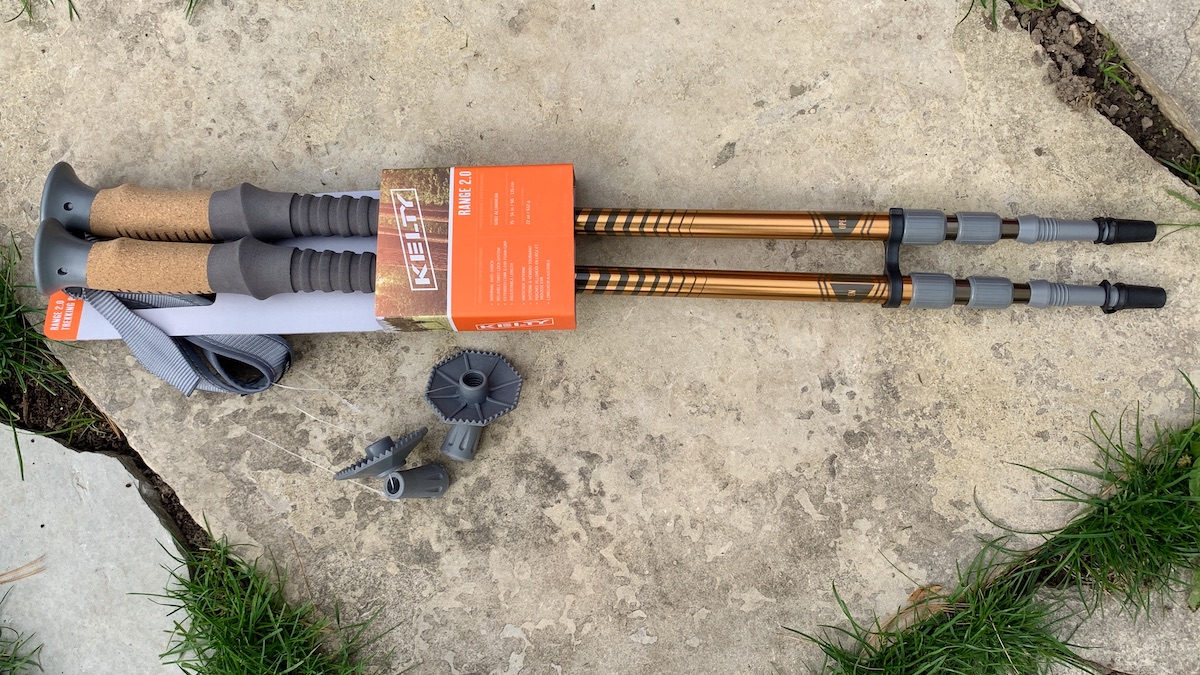The fall hiking season is well underway—at least where I live in southwestern Ontario. The autumn leaves display has passed its peak and there’s been one brief snowfall, but it’s cool and there are no bugs. Perfect hiking weather! This time of year especially, I prefer to have a hiking pole with me. When it rains, the cool weather means it takes a lot longer for water to evaporate, so muddy trails are not uncommon. All the leaves on the ground can also make for slippery going. Having a hiking pole gives more stability, and it’s a game-changer when facing a slippery hill. For the past few weeks, I’ve been trying out the Kelty Range 2.0 trekking poles—with my wife and I each using one as a hiking pole.
Light, Adjustable, and Strong
I’ve never used trekking poles as actual walking poles. They seem especially popular with seniors walking in our area, but I’ve never felt the need for adding a pair of poles to my daily walks. However, I do frequently bring a hiking pole when I hit the trail. Especially when the area is known to be wet, muddy, slippery, hilly, or full of tree roots. Which covers most forest trails around here, frankly…
Most trekking poles—including Kelty’s Range 2.0—are sold as a pair, but can be used individually. One each for my wife and me, so that works out.
The Kelty Range 2.0 poles are quite light, at 11oz each. The shafts are made of 6061 series anodized aluminum, which helps keep that weight down while making them strong. They can extend from 35-inches to 54-inches in length, with twist-lock mechanisms. They are spring-loaded for shock absorption. The handles are cork and EVA, with lightly padded, adjustable wrist straps. Tips are non-slip carbide, and Kelty includes screw-on rubber tips and trekking baskets. These add-ons reduce noise/marking on hard surfaces and prevent the poles from sinking deeply in the ground, respectively.
The poles came in an attractive orange color, with grey and black trim, with a $55.99 MSRP.
Range 2.0 Poles in Action
I’m not a hardcore hiker, but my wife and I get out and on the trails as much as possible. My longest single-day hike at this point is 33 miles, but the more typical length is in the 4 miles to 13 miles range—weekdays are typically the shorter hikes.
It was on this sort of short hike that we’ve been using the Kelty poles. It’s been a lot of time tromping through local wooded trails, hilly and increasingly covered with fallen leaves. There’s been a little more rain than usual, so some of the trails have been quite muddy as well.
I have several other hiking poles, but one has a rubber grip, and the other lacks the Kelty’s shock absorber feature. I prefer the handgrip on the Kelty poles—mostly cork, it doesn’t get as slippery if you’re sweating, and it’s starting to physically mold to my hands. The strap is also more comfortable. I’ve also quickly come to appreciate the shock absorber feature. It did a nice job of cushioning the impact, especially when descending steep hills.
The poles were easily adjusted to both of our heights (my wife is 5′ 4″ and I’m 6′), and also supported my 230 lb frame.
In general, the Kelty Range 2.0 poles did their job well, keeping us on-balance in twisty terrain, helping to push up on steep climbs, helping to keep steep descents under control, and providing extra stability when navigating slippery surfaces. A hiking pole is also nice to have when trying to gauge just how deep a pool of water stretching across your path is…
Recommendation
If you’re a serious hiker, you probably want a more serious hiking pole: one that’s a bit lighter, with a replaceable tip and external locking mechanism. That can be a significant investment. However, for casual use, I found the Kelty Range 2.0 trekking poles make for more than acceptable hiking poles. They’re definitely a noticeable upgrade over the others I own. They make a big difference on the trail—especially in hilly and slippery conditions—and at $56 for the pair, they’re pretty affordable.
Disclosure: Kelty provided trekking poles for evaluation but had no input into this review. As an Amazon Associate, I earn affiliate fees from qualifying purchases.




